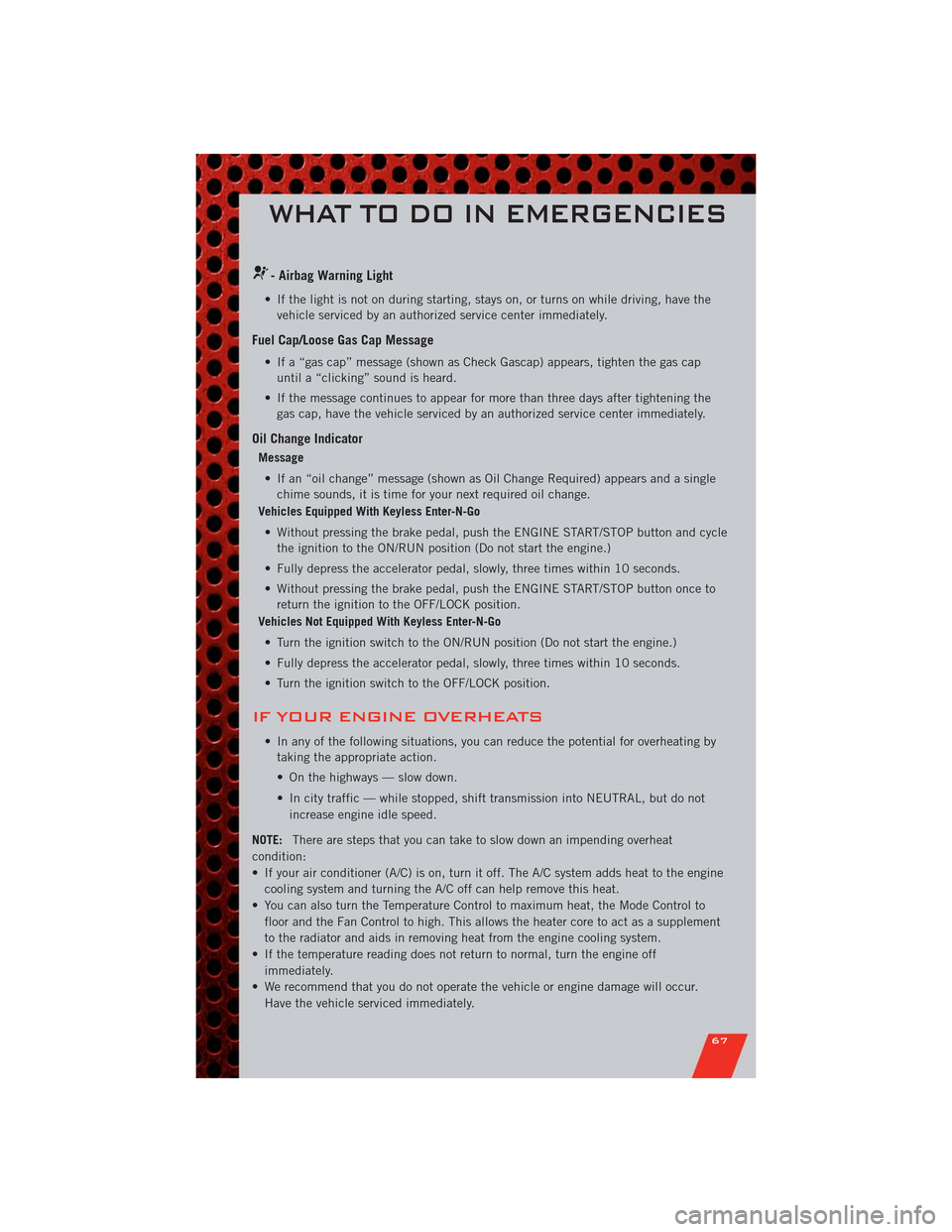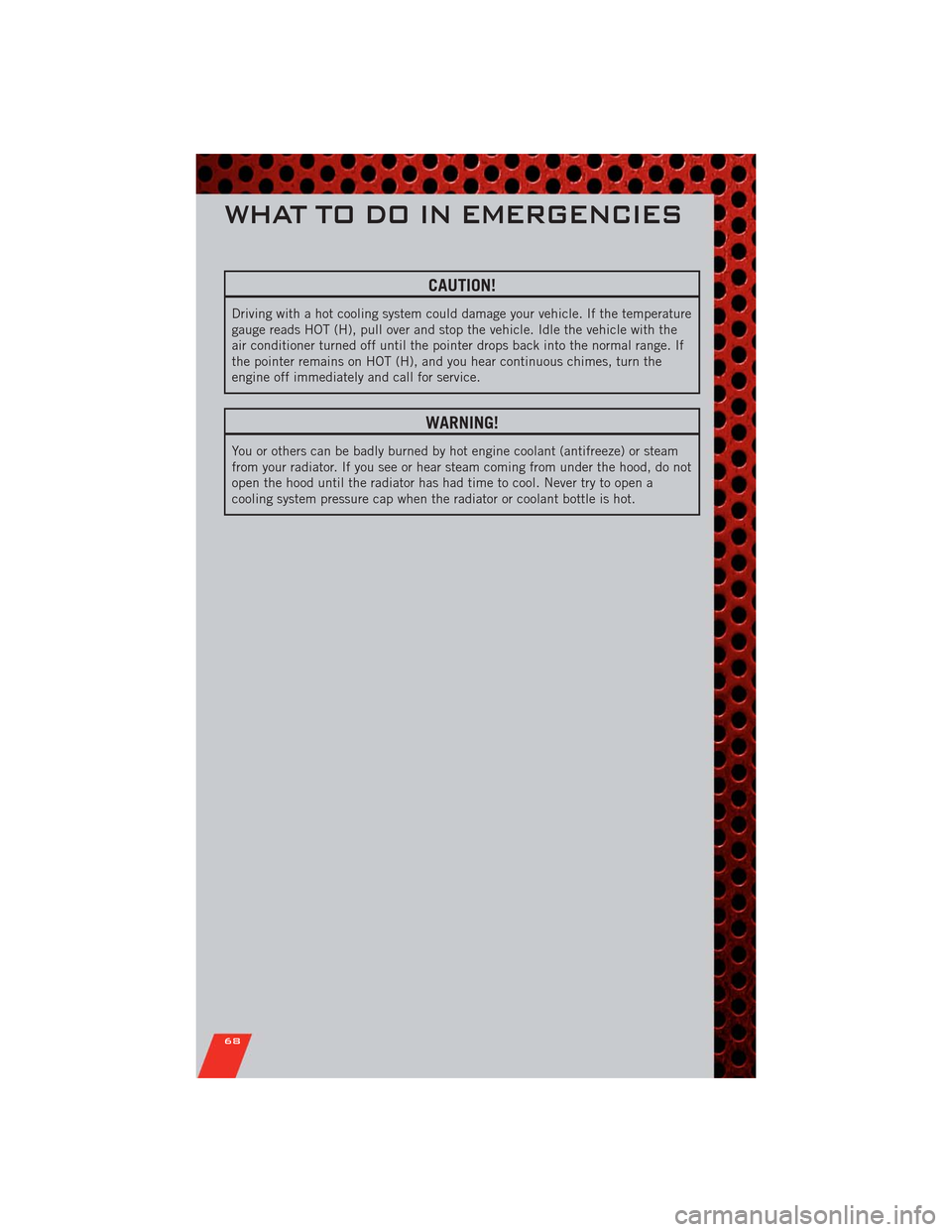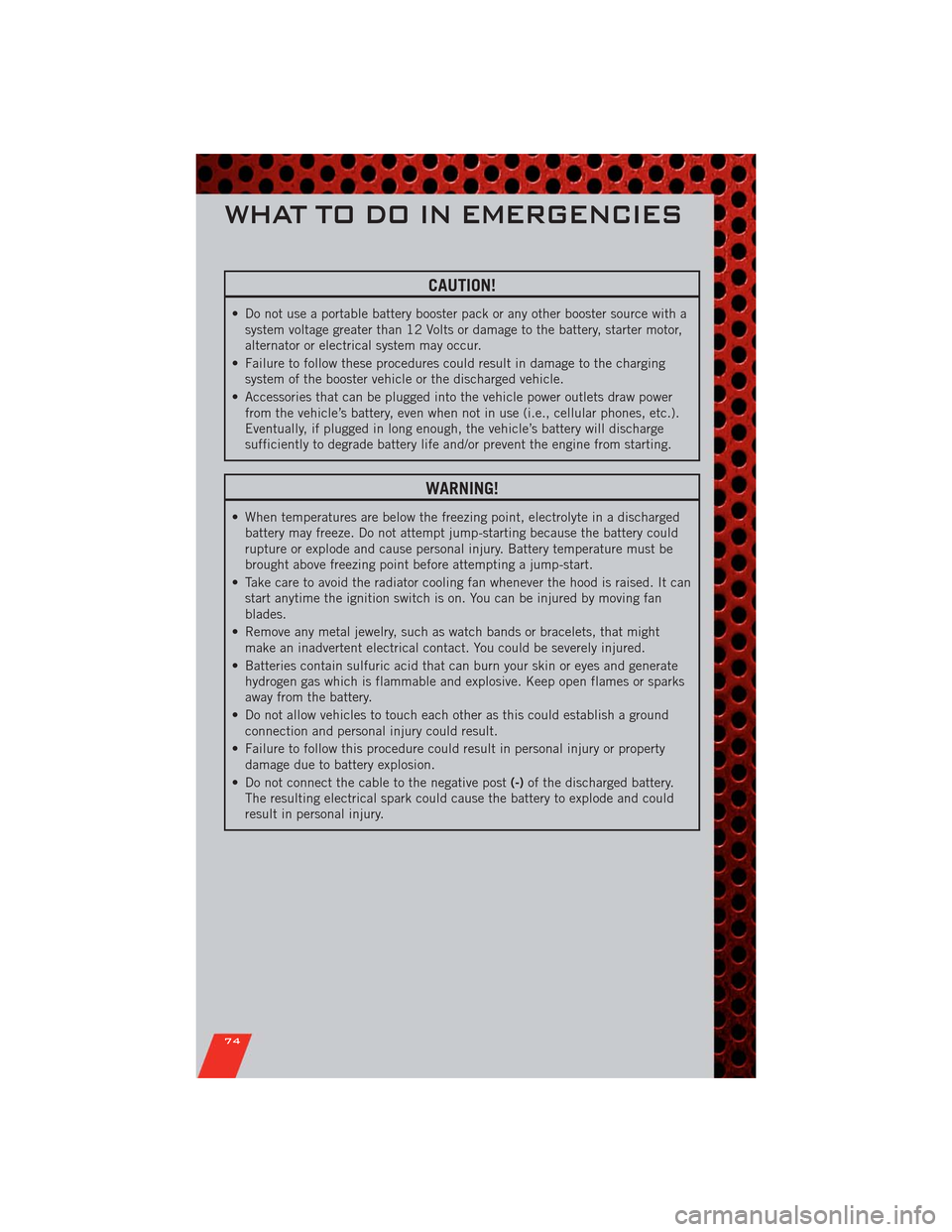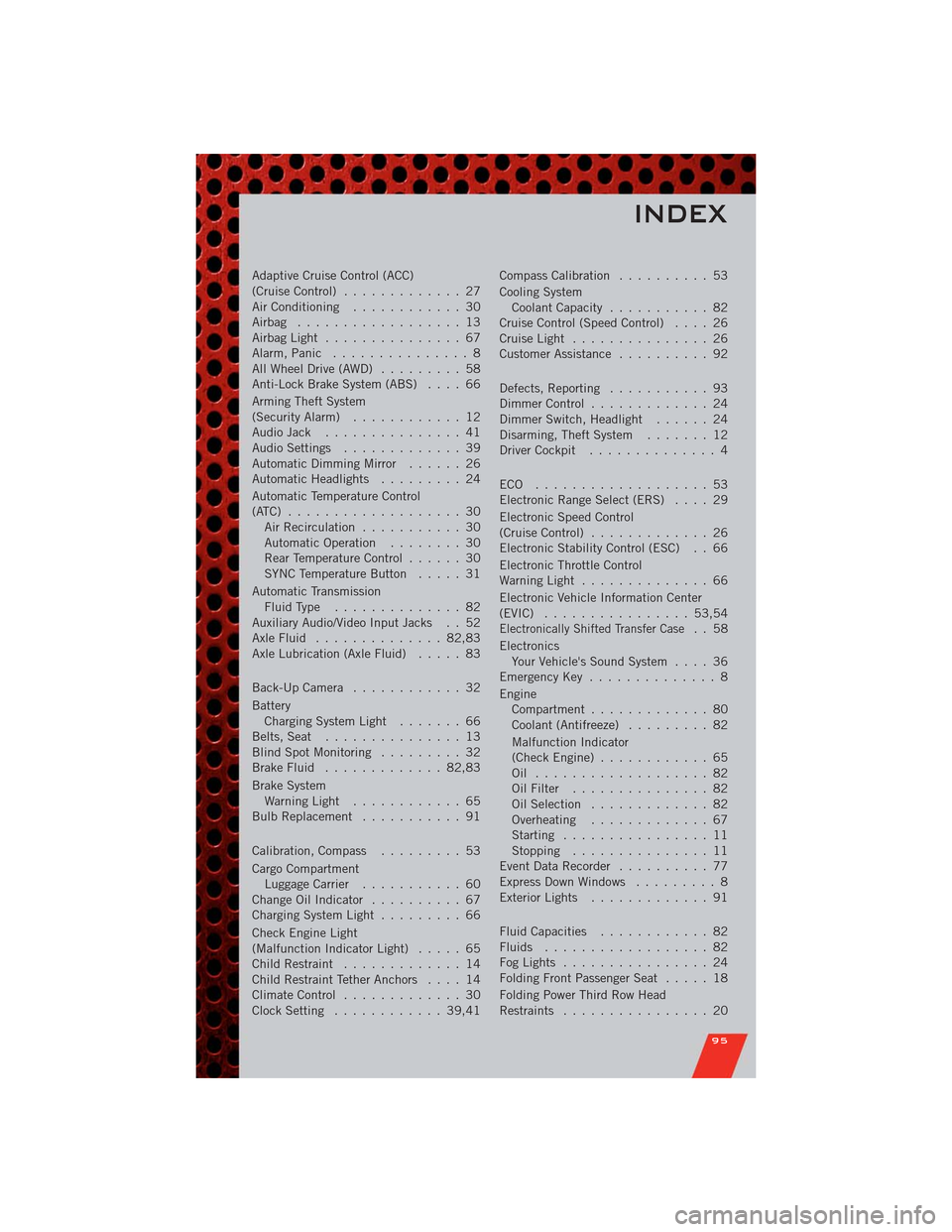cooling DODGE DURANGO 2011 3.G User Guide
[x] Cancel search | Manufacturer: DODGE, Model Year: 2011, Model line: DURANGO, Model: DODGE DURANGO 2011 3.GPages: 108, PDF Size: 5.96 MB
Page 69 of 108

- Airbag Warning Light
• If the light is not on during starting, stays on, or turns on while driving, have the
vehicle serviced by an authorized service center immediately.
Fuel Cap/Loose Gas Cap Message
• If a “gas cap” message (shown as Check Gascap) appears, tighten the gas cap
until a “clicking” sound is heard.
• If the message continues to appear for more than three days after tightening the
gas cap, have the vehicle serviced by an authorized service center immediately.
Oil Change Indicator
Message
• If an “oil change” message (shown as Oil Change Required) appears and a single
chime sounds, it is time for your next required oil change.
Vehicles Equipped With Keyless Enter-N-Go
• Without pressing the brake pedal, push the ENGINE START/STOP button and cycle
the ignition to the ON/RUN position (Do not start the engine.)
• Fully depress the accelerator pedal, slowly, three times within 10 seconds.
• Without pressing the brake pedal, push the ENGINE START/STOP button once to
return the ignition to the OFF/LOCK position.
Vehicles Not Equipped With Keyless Enter-N-Go
• Turn the ignition switch to the ON/RUN position (Do not start the engine.)
• Fully depress the accelerator pedal, slowly, three times within 10 seconds.
• Turn the ignition switch to the OFF/LOCK position.
IF YOUR ENGINE OVERHEATS
• In any of the following situations, you can reduce the potential for overheating by
taking the appropriate action.
• On the highways — slow down.
• In city traffic — while stopped, shift transmission into NEUTRAL, but do not
increase engine idle speed.
NOTE:There are steps that you can take to slow down an impending overheat
condition:
• If your air conditioner (A/C) is on, turn it off. The A/C system adds heat to the engine
cooling system and turning the A/C off can help remove this heat.
• You can also turn the Temperature Control to maximum heat, the Mode Control to
floor and the Fan Control to high. This allows the heater core to act as a supplement
to the radiator and aids in removing heat from the engine cooling system.
• If the temperature reading does not return to normal, turn the engine off
immediately.
• We recommend that you do not operate the vehicle or engine damage will occur.
Have the vehicle serviced immediately.
WHAT TO DO IN EMERGENCIES
67
Page 70 of 108

CAUTION!
Driving with a hot cooling system could damage your vehicle. If the temperature
gauge reads HOT (H), pull over and stop the vehicle. Idle the vehicle with the
air conditioner turned off until the pointer drops back into the normal range. If
the pointer remains on HOT (H), and you hear continuous chimes, turn the
engine off immediately and call for service.
WARNING!
You or others can be badly burned by hot engine coolant (antifreeze) or steam
from your radiator. If you see or hear steam coming from under the hood, do not
open the hood until the radiator has had time to cool. Never try to open a
cooling system pressure cap when the radiator or coolant bottle is hot.
WHAT TO DO IN EMERGENCIES
68
Page 76 of 108

CAUTION!
• Do not use a portable battery booster pack or any other booster source with a
system voltage greater than 12 Volts or damage to the battery, starter motor,
alternator or electrical system may occur.
• Failure to follow these procedures could result in damage to the charging
system of the booster vehicle or the discharged vehicle.
• Accessories that can be plugged into the vehicle power outlets draw power
from the vehicle’s battery, even when not in use (i.e., cellular phones, etc.).
Eventually, if plugged in long enough, the vehicle’s battery will discharge
sufficiently to degrade battery life and/or prevent the engine from starting.
WARNING!
• When temperatures are below the freezing point, electrolyte in a discharged
battery may freeze. Do not attempt jump-starting because the battery could
rupture or explode and cause personal injury. Battery temperature must be
brought above freezing point before attempting a jump-start.
• Take care to avoid the radiator cooling fan whenever the hood is raised. It can
start anytime the ignition switch is on. You can be injured by moving fan
blades.
• Remove any metal jewelry, such as watch bands or bracelets, that might
make an inadvertent electrical contact. You could be severely injured.
• Batteries contain sulfuric acid that can burn your skin or eyes and generate
hydrogen gas which is flammable and explosive. Keep open flames or sparks
away from the battery.
• Do not allow vehicles to touch each other as this could establish a ground
connection and personal injury could result.
• Failure to follow this procedure could result in personal injury or property
damage due to battery explosion.
• Do not connect the cable to the negative post(-)of the discharged battery.
The resulting electrical spark could cause the battery to explode and could
result in personal injury.
WHAT TO DO IN EMERGENCIES
74
Page 97 of 108

Adaptive Cruise Control (ACC)
(Cruise Control)............. 27
Air Conditioning............ 30
Airbag .................. 13
AirbagLight ............... 67
Alarm,Panic ............... 8
All Wheel Drive (AWD)......... 58
Anti-Lock Brake System (ABS).... 66
Arming Theft System
(Security Alarm)............ 12
Audio Jack............... 41
Audio Settings............. 39
Automatic Dimming Mirror...... 26
Automatic Headlights......... 24
Automatic Temperature Control
(ATC) ................... 30
Air Recirculation........... 30
Automatic Operation........ 30
Rear Temperature Control...... 30
SYNC Temperature Button..... 31
Automatic Transmission
FluidType .............. 82
Auxiliary Audio/Video Input Jacks . . 52
AxleFluid .............. 82,83
Axle Lubrication (Axle Fluid)..... 83
Back-Up Camera............ 32
Battery
Charging System Light....... 66
Belts, Seat............... 13
Blind Spot Monitoring......... 32
Brake Fluid............. 82,83
Brake System
WarningLight ............ 65
BulbReplacement ........... 91
Calibration,Compass ......... 53
Cargo Compartment
Luggage Carrier........... 60
ChangeOilIndicator .......... 67
Charging System Light......... 66
Check Engine Light
(Malfunction Indicator Light)..... 65
Child Restraint............. 14
Child Restraint Tether Anchors.... 14
Climate Control............. 30
Clock Setting............ 39,41Compass Calibration.......... 53
Cooling System
Coolant Capacity........... 82
Cruise Control (Speed Control).... 26
CruiseLight ............... 26
Customer Assistance.......... 92
Defects, Reporting........... 93
Dimmer Control............. 24
Dimmer Switch, Headlight...... 24
Disarming, Theft System....... 12
Driver Cockpit.............. 4
ECO ................... 53
Electronic Range Select (ERS).... 29
Electronic Speed Control
(Cruise Control)............. 26
Electronic Stability Control (ESC) . . 66
Electronic Throttle Control
WarningLight .............. 66
Electronic Vehicle Information Center
(EVIC) ................ 53,54
Electronically Shifted Transfer Case.. 58
Electronics
Your Vehicle's Sound System.... 36
Emergency Key.............. 8
Engine
Compartment............. 80
Coolant (Antifreeze)......... 82
Malfunction Indicator
(CheckEngine) ............ 65
Oil ................... 82
Oil Filter............... 82
Oil Selection............. 82
Overheating............. 67
Starting................ 11
Stopping ............... 11
Event Data Recorder.......... 77
Express Down Windows......... 8
Exterior Lights............. 91
Fluid Capacities............ 82
Fluids .................. 82
FogLights ................ 24
Folding Front Passenger Seat..... 18
Folding Power Third Row Head
Restraints................ 20
INDEX
95